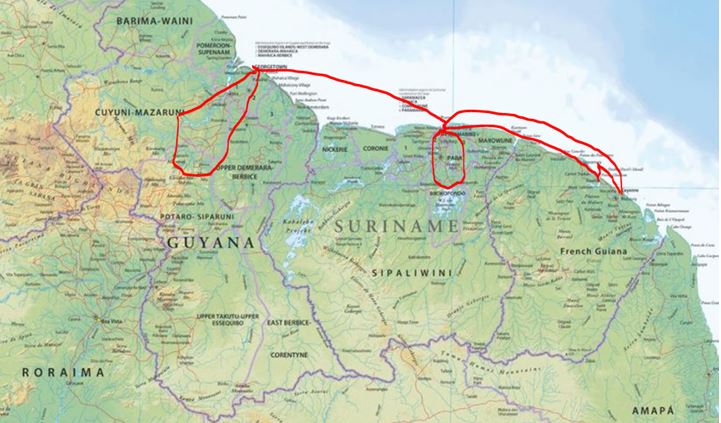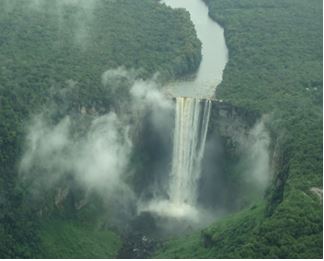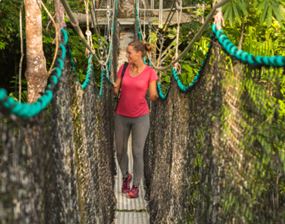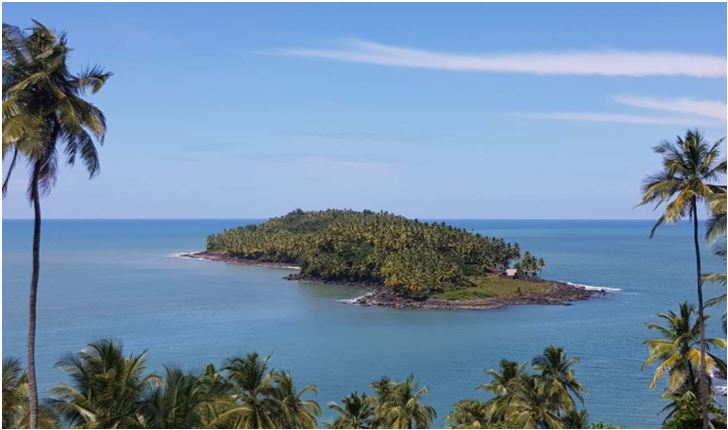- Overview
- Trip Outline
- Pricing
- Trip Includes
- Trip Excludes
- Gallery
- Reviews
- FAQ
Route:

Technical Characteristics:
Route Profile: Easy. Suitable for people with a reasonable fitness level who enjoy wildlife, nature and pristine environments.
Travel Season: Departures February 23; March 23; April 13; August 24; September 21 and November 9, 2023
Other departures available on special request
*Group rates available for this tour. As this is a guided tour, the pricing improves with more people participating. Please ask us for details.
Accommodation:
Guests are accommodated in a mix of a heritage house hotel and rainforest lodges
The Guiana Shield is a 1.7 billion year old Precambrian geological formation in northeast South America and is one of the regions of highest biodiversity in the world. The shield has 1400 vertebrate species and 1680 bird species and is overlain by the largest expanse of undisturbed tropical rain forest in the world. Join us as we explore the Guianas: Guyana, Suriname and French Guiana. Marvel at Kaieteur Falls, the highest single drop waterfall in the world and discover one of the greatest untouched rainforests left. This region is home to endangered species such as jaguar, giant anteater, giant river otter, tapir and so much more. Spend time learning about the cultures of the region with visits to Amerindian and Maroon communities. Be amazed at the Space Centre in French Guiana and relive the story of Papillion at Devils Island. This really is an untouched and totally unique part of South America.
Itineraries
Day 1
Arrival to Paramaribo, Suriname
We will pick you up at the JA Pengal International airport and transfer you to the hotel, Eco Torarica. The Eco Torarica is located within a five minute walk of the historic center of Paramaribo and the tantalizing city life. Rooms offer either a breath-taking view of the Suriname River or a beautiful view of the lovely garden.
Day 2
Paramaribo - Danpaati River Lodge
This morning we start our nature and cultural experience as we depart from Paramaribo. After travelling a distance of approximately 190 km you arrive at the village of Atjoni. At the port of Atjoni join a motorized canoe, where our skilled personnel will navigate their way up the Upper Suriname River, which is famous for its breathtaking rapids, to the Danpaati River Lodge. The Danpaati River Lodge is an exceptionally remote and tranquil oasis in the heart of nature, welcoming adventurous visitors in search of an escape from modern stresses and distractions. The lodge features a welcoming and breezy lounge facing the river, a large pool surrounded by a hardwood yoga deck, and easy access to one of the few portions of the Suriname River where it is actually safe to swim. Our day comes to an end with an exciting cruise on the river, looking for caiman lying on the river banks.

Day 3
Danpaati River Lodge
Today we will visit one of the 12 villages that are affiliated with Danpaati. We will have a guided tour through the village and you will be introduced to the wonderful traditions brought from Africa by their ancestors. After the tour we will visit the Maroon museum Saamaka which is dedicated to the cultural heritage of the Saramak Maroon population. Pikinslee is located 30 minutes by boat from Danpaati. In the museum you will learn about the Maroon’s history, and their ancient traditions and crafts. After the tour we return to the lodge for lunch. In the afternoon, we will discover some of the secrets of the rainforest during our walk in the woods. Afterwards you could choose to enjoy a massage done in a combination of traditional and Western techniques. Possibilities to explore the surrounding area are available; fishing or taking the dugout canoe around the island.

Day 4
Danpaati River Lodge - Paramaribo
This morning we still have some time to enjoy the beautiful surroundings and take pictures. After saying good bye to the staff, we depart by dugout canoe from Danpaati to Atjoni. From Atjoni we will continue our journey back to Paramaribo by vehicle.
Day 5
Paramaribo
Paramaribo, the capital city of Suriname, has been placed on the UNESCO “World Heritage” list of historical monuments since 2002. You receive a guided tour, by car and on foot, along the most prominent historic locations in downtown Paramaribo during which you will be impressed by the unique architecture. The guide gives you extensive information about the former “Fort Zeelandia”, the Presidential Palace, the Independence Square and many other monuments. The monumental buildings are a true representation of the colonial history of Suriname. After a stroll pass the Waterkant, along the bank of the Suriname River and through the Palms Garden, you will also enjoy other interesting sites such as a mosque right next to a synagogue. We proceed to the Commewijne district which is situated to the east of Paramaribo across the Suriname River. The tour takes us along the former colonial plantations, most of which are now abandoned. We make a stop at plantation Peperpot where the old coffee and cocoa factory, deputy director’s house and the old office are located. This former plantation is one of the oldest plantations in Surinamese history. Peperpot was established by the English and already existed before Suriname was conquered by the natives from Zeeland under command of Abraham Crijnssen in 1667. This is one of the last plantations still in its former original state. On the plantation you can still see coffee and cocoa plants as well as an ancient shed and factory, the manager’s residence and a kampong (workers’ living area). Peperpot is renowned for the many birds which can be spotted. From Peperpot, we make a stop at the mini-museum of Marienburg, a former sugar plantation before enjoying a delicious lunch in a typical Javanese restaurant (warung) in Tamanredjo. We then continue to the confluence of the Commewijne and Suriname Rivers at Nieuw Amsterdam. Here we will visit the outdoor museum Fort Nieuw Amsterdam. The large fortress was built as a defense for the crop fields that were situated along the upper parts of both rivers. After the tour we will transfer you to Paramaribo.

Day 6
Paramaribo - Kourou, French Guiana
After breakfast we make an early start to comfortably pace ourselves through the journey. The first leg of our travels takes us eastbound along Suriname's coastal road, to Albina border station. Formalities here rarely take more than a few minutes, and soon we find ourselves on the ferry crossing the Maroni River headed for French Guiana or "Guyane" as it is frequently (and confusingly) called locally. Arrival at St. Laurent du Maroni is relatively uncomplicated, and our French guide will be on hand to help us navigate the usual customs and immigration formalities. Guyane Francaise is a Department of France, so technically you have entered the EU. Evidence of this connection to the "1st world" is immediately evident: every car seems to be a late model Mercedes, Volkswagen or Peugeot, the roads are in near perfect condition, espresso coffee is on tap nearly everywhere, and the Euro is the currency. We will continue our journey to Kourou. Visit the Center Spatiale Guyanaise (Guyana Space Center) for a tour. Launch schedules are a closely held secret so our schedule today may be amended on short notice. The usual tour includes a motor coach tour which crisscrosses the center’s mammoth facility, including stops at various assembly buildings, launch pads and control centers. The entire tour is offered in French, but your guide will supply translations as often as possible.

Day 7
Devil’s Island and Cayenne
What is commonly referred to as “Devil’s Island” is really a triangle of three islands - Îles du Salut, or the Salvation Islands – 11 kilometers off the coast of Kourou. After a breakfast buffet at the hotel, we set sail aboard a fine motorized catamaran towards our first stop, Île Saint-Joseph. The islands played a central role in French history as far back as 1792 when they were first employed as a transit point, first for explorers, then slaves and later for political prisoners and convicts. Île Saint-Joseph is the southernmost island and was known as the silent island as inmates were not allowed to speak with other inmates or the guards. Papillion claimed to have spent two years in solitary on St Joseph. It was called the ‘man eater’ for obvious reasons. Île Royale is the site of the oldest buildings on the islands, featuring an old church, administration buildings, officers' quarters, and today, a good restaurant, café and lodging facilities. Ironically, the actual Île du Diable (Devil's Island) is inaccessible to visitors due to dangerous shoreline conditions. This is the island where the prison's best-known occupant, Alfred Dreyfus, was famously secluded and where Papillion said he was able to escape on a coconut raft. You will spend most of the day on Île Royale. Visit the children’s cemetery behind the old hospital which was used for the children of the guards. Land was at a premium so only the children were buried. The inmates were buried at sea to encourage the sharks to serve as a deterrent to prisoners wanting to swim off the island. Make sure to be back at the dock by about 3:30 p.m. as the boat leaves promptly at 4:00 p.m. There are plenty of shady trees with benches under which you can catch a cool breeze. Keep an eye out for sea turtles that like to scavenge among the rocks by the dock. Return to Kourou by catamaran and transfer to Cayenne and to your hotel.

Day 8
Cayenne - Paramaribo
Early morning to explore Cayenne before our mid-morning transfer to the border of St. Laurent du Maroni. On our way we will make a brief stop in St Joseph’s church, in Iracoubo. The entire inside of the church was hand painted by one of the convicts from a nearby penal colony. Upon arrival of St. Laurent enjoy a mini city tour of St. Laurent du Maroni where we will pay a brief visit to the well-preserved Transportation Centre. The facility once served as the arrival station where convicts were processed to the various penal colonies in French Guiana. Starting in the mid-18th century the majority of convicts were transported to French Guiana and served their various convictions. They then had to spend the same amount of time here as their sentence before gaining their freedom. This was a way to try to populate the colony. One of the most famous inmates was Papillion whose initials are carved in one of the cells. Continue to the immigration and then cross by Pirogue to Albina and onwards to Paramaribo where we will spend the night.
Day 9
Flight to Georgetown
Pick up from your hotel in Paramaribo and transfer to the local airport Zorg-en-Hoop for your GUMAIR flight departing at 7:30 a.m. to Georgetown, arriving at 7:45 a.m. Our host, guide and culinary master, Chef Delven Adams will guide us around Bourda Market, the largest of the four markets in Georgetown. We will first stop at the Guyana Store which has all the local products produced and packaged in Guyana before heading over to the market where we will meet some of the vendors who the chef buys from daily. We will visit the fish market, the meat section and the haberdashery section - where one can find anything you can think of from thread to bolts of all kinds of fabric. Dry goods like rice and of course demerara sugar are abundant. A stop at the bush medicine stalls is always educational. Heading outside you can see, touch and taste a variety of local fruits and vegetables unique in this part of the world. Chef will make his purchases with your suggestions of what you would like to try and will then head home to start preparing while we continue on a tour of the city of Georgetown with an experienced guide who will give you the history, rumour and facts on Georgetown and its citizens. During your visit to Georgetown there are a number of interesting sights that should not be missed such as Stabroek Market - once described as a “bizarre bazaar, and St. George’s Cathedral which is one of the world’s tallest free standing wooden buildings. Other historic buildings along this promenade are the Public Library, City Hall, the Victoria Law Courts and St. Andrews Kirk. Visit the National Museum, which contains a broad selection of our animal life portrayed in taxidermy in beautiful old glass cases, and the Walter Roth Museum of Anthropology, which houses a wonderful collection of artefacts and explains Amerindian history and life style. We will also pay a visit to a pond either in the gardens or the National Park, to feed the endangered West Indian Manatees. After our city tour we will go to the Backyard Café for lunch. This, as the name suggests, is a backyard that Chef has turned into an exclusive little hidden gem of a restaurant. If you are interested, Chef will welcome you to join him as he prepares a wonderful meal prepared from the fruits and vegetables we bought in the market in the morning. Or you can just sit under the arbour and sip unique blends of juice or enjoy a cold beer, while taking in the sounds and smells of a delicious meal in the making. Once he is ready, we will start eating our way through the courses, remember to pace yourself as you will want to try it all. After lunch we will visit the Botanical Gardens, home to an extensive collection of tropical flora, and the Zoo which has become a wildlife rescue and rehabilitation center that houses over one hundred different species of tropical wildlife. We will take a drive through the heart of the city to the Stabroek Market area. Here you will join the afternoon commuters using the old ferry stelling to board the river taxis which are used to cross the Demerara River. The river taxis are an alternative route to using the Demerara Harbor Bridge. As you slowly cruise along the bank of the Demerara River your guide will give you a brief history of the famous buildings along the waterfront. We then continue our trip to see the Demerara Harbour Bridge, once the longest floating bridges in the world at a total length of 1,851 meters. We will cross under the bridge and tie up the boat near a mangrove that is the nightly roost of about nine different kinds of birds. As the sun sets over the river we will have a cold drink and snacks (or cutters as we call them in Guyana) while we enjoy flocks of brilliant scarlet ibis and three kinds of egrets as they fly across the sky and settle into the mangroves for the evening. Soon after the sun sets you return to the ferry stelling while enjoying the city and ship lights from the river.

Day 10
Kaieteur Falls and Georgetown
Pickup and transfer to Eugene F. Correia International Airport for a scheduled flight over the Demerara and Essequibo Rivers and hundreds of kilometers of unbroken tropical rainforest to land at Kaieteur Falls, the world’s highest free falling waterfall. Kaieteur, which was first seen by a European on April 29, 1870 is situated in the heart of Guyana on the Potaro River, a tributary of the Essequibo. The water of Kaieteur flows over a sandstone conglomerate tableland into a deep gorge - a drop five times the height of Niagara Falls. Amerindian legend of the Patamona tribe has it that Kai, one of the tribe’s chiefs (after whom the falls is named), committed self-sacrifice by canoeing himself over the falls. It was believed this would encourage the Great Spirit Makonaima to save the tribe from being destroyed by the savage Caribishi. Return to Georgetown.

Day 11
Iwokrama River Lodge and Atta Rainforest Lodge
Pickup and transfer to Eugene F. Correia International Airport. Board schedules flight for journey over hundreds of kilometers of tropical rainforest to land at Fair View Airstrip. (Check in time 7:00 a.m., departure 8:30 a.m.). Pick up from Fair View Airstrip and transfer to Iwokrama River Lodge. After your orientation you will depart the lodge by boat, birdwatching along the way, for the hike to Turtle Mountain. A well maintained trail winds through the forest before an exhilarating climb up the mountain to its summit at approximately 360 meters). It takes 1 ¾ hours to walk up the mountain, but the effort is more than worth it for the breathtaking views over the forest canopy and the chances of spotting green aracari, white bellbird or a fly-by of one of five types of eagles. This trail is also a great location for seeing black spider and red howler monkeys. If you think this hike may be too strenuous you can take an alternative boat trip to Stanley Lake to search for giant river otters and black caiman. Return to the lodge for lunch and then transfer by vehicle along the trail that is one of the best places to see the elusive jaguar. No promises, but many have been lucky! This road is the only north – south access in Guyana and links the country to Brazil. Even so traffic is only very occasional and wildlife is often seen along the road, such as agouti, tayra, tapir and black curassow. The journey concludes at the Atta Rainforest Lodge, home of the Iwokrama Canopy Walkway. The Iwokrama Canopy Walkway is situated near the southern boundary of the Iwokrama Reserve. The walkway has four suspension bridges leading to three platforms, the highest of which is over 30 meters above the ground, and these allow great looks at a range of canopy species, many of which you would struggle to see well from the forest floor. Another area where we will want to spend some time is the clearing around the lodge, as this is one of the best places to see another of Guyana’s “must see” birds, the crimson fruitcrow. This species is seen here on a reasonably regular basis, as it often comes to feed in some of the nearby trees. The clearing is also a reliable site for black curassow as there is a family party which has become habituated to people and regularly passes through the clearing.
Day 12
Atta Rainforest Lodge - Surama Eco-Lodge
Before dawn return to the canopy where you will welcome the dawn chorus. From this tree top vantage you can sometimes see red howler and black spider monkeys. Apart from the Iwokrama Canopy Walkway itself you can enjoy wildlife and birdwatching walks on the trails around the area. For those interested in botany many of the trails have the key tree species marked. Many bird species, stunning insects, noisy amphibians, and playful primates make the surrounding forest their home. Deer, tapir and agouti are also regular visitors to the lodge. Return to the lodge for breakfast before departure. Transfer from Atta Rainforest Lodge by vehicle through the rainforest to Corkwood in the Iwokrama Forest. Here there is a comparatively short trail to hopefully see the amazingly brilliant Guianan cock-of-the-rock. This trail is through interesting and pristine rainforest and the guides can explain how the plants are used for medicine and other purposes. Continue the journey to the community of Surama. The Amerindian community of Surama is located in the heart of Guyana. The village is set in eight square kilometers of savannah which is ringed by the forest covered Pakaraima Mountains. Surama’s inhabitants are mainly from the Macushi tribe and still observe many of the traditional practices of their ancestors. The Surama Eco Lodge is owned and operated by the community. There is a rotating schedule that allows many villagers to earn a salary. The village council as the board of directors decides how the profits are to be spent to benefit the whole village. On arrival in Surama you will receive a warm welcome and settle into your accommodation at the lodge. A guide will escort you for a short walk on trails to observe the forest and bird life. As the afternoon cools your guide will take you on a tour of the village. Visit the local school, medical center and church along with some of the village houses. Tonight, enjoy an educational walk to observe wildlife and experience the mystique of the forest after dark. Make sure to bring your flashlights to look for the eye shine of the creatures of the night.

Day 13
Surama Eco-Lodge
Rise before dawn for a walk across the savannah and then climb up Surama Mountain for incredible views across the village and savannah to the Pakaraima Mountains. This is not a technical climb but can be arduous, especially after rain, and not for everyone. Your guides will happily offer alternative activities if you prefer not to do this climb. Return to the lodge for lunch and then take a five kilometer walk across the savannah and through the rainforest to the Burro Burro River. Your guides will then paddle you on the Burro Burro River for opportunities to observe giant river otters, tapir, tayra, spider monkeys and more species. Return to the lodge for sunset.

Day 14
Surama Eco-Lodge - Georgetown
Enjoy dawn breaking across the rainforest. You can choose from a forest walk to look for wildlife and birds or relax around the lodge before breakfast and departure. Pick up from Surama Eco Lodge and transfer to airstrip for a scheduled flight to the Eugene F. Correia International Airport. Pickup and transfer to your hotel.
Day 15
Depart Guyana
Pickup and transfer to Cheddi Jagan International Airport for your departing flight.
Prices
Included:
- Airport transfers
- Double or twin accommodation
- Meals as listed (14 breakfasts, 9 lunches and 5 dinners)
- All road and river transfers
- Internal flights in Guyana
- Activities as described
- Local guides
- Kaieteur National Park fee
- Iwokrama Forest User Fee
- Iwokrama Canopy Walkway fee
Not Included:
- Items of a personal nature
- Alcoholic drinks except where mentioned above
- Departure tax
- International flights
- Visa if required
No Details Found
















There are no reviews yet.